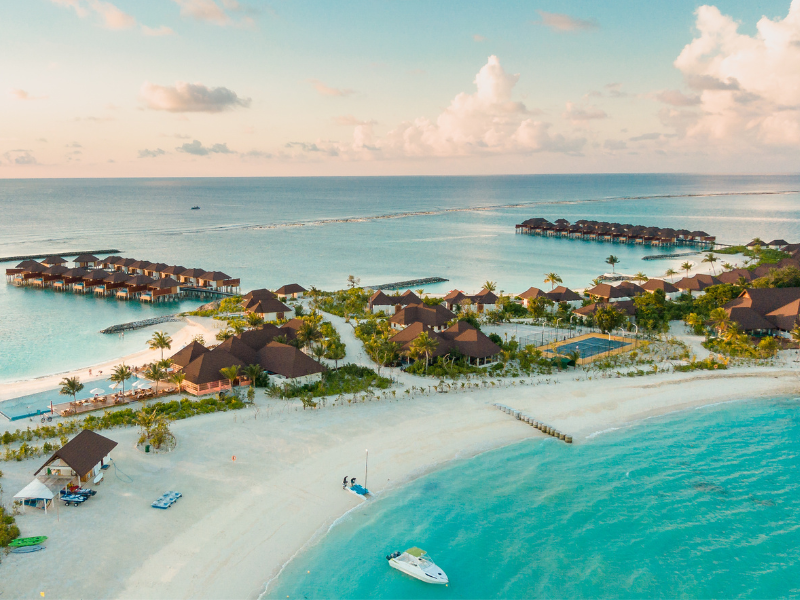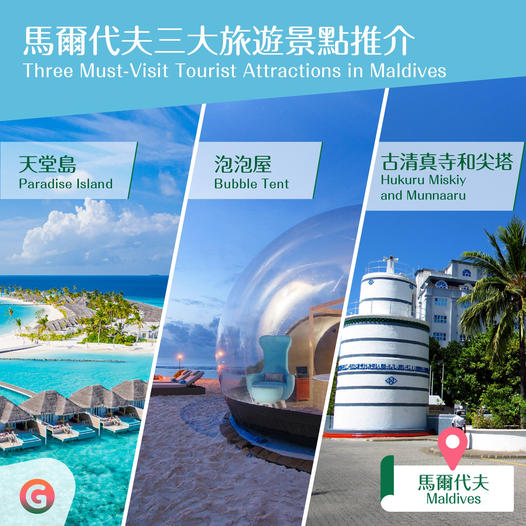人間天堂 - 馬爾代夫
 瑪律地夫天氣預告
瑪律地夫天氣預告





分享文章至:

人間天堂 - 馬爾代夫
如果您喜歡陽光與沙灘,絕對不能錯過人間天堂的馬爾代夫。
馬爾代夫是印度洋上的一個島國,橫跨赤道。全國由 1192 個島嶼組成,綿延 871 公裡。國家面積約 9 萬平方公裡,其中只有 298 平方公裡是陸地。這些島嶼由 26 個環礁組成雙鏈。
該國獨特的地理環境令遊客著迷。色彩斑斕的珊瑚礁、寶石般的小島、最潔白柔軟的沙灘、清澈見底的淺水。只有 200 個島嶼有人居住,每個環礁上都有少數幾個度假村,還有一些島嶼用於工業和農業。
馬爾代夫的美麗不僅體現在水面上。馬爾代夫擁有地球上約 5% 的珊瑚礁,這些珊瑚礁由軟珊瑚和硬珊瑚組成,色彩斑斕。珊瑚礁是上千種魚類的家園。蝠鲼和鯨鯊等大型中上層魚類受到隨水流而來的豐富營養物質的誘惑,也在馬爾代夫安家落戶。

雖然對馬爾代夫的古代歷史知之甚少,但學者和歷史學家認為,馬爾代夫是一個古老的國家,2500 多年前就有人居住。馬爾代夫人種是印度次大陸各地幾波定居浪潮的結果,也是幾個世紀以來不同種族和民族的人們在印度洋上縱橫交錯的數千年交往的結果。馬爾代夫的文化和傳統以及人民多樣的體貌特征證明,由於其地理位置,馬爾代夫是人民和文化的大熔爐。馬爾代夫的語言是迪維希語,一種起源於梵語的印度-雅利安語。
根據 2014 年的最新人口普查,馬爾代夫人口為 407 660 人。三分之一的人口居住在馬累,其余人口居住在全國各地的 200 個島嶼上。
馬爾代夫人的生計傳統上依賴海洋,漁業是主要的生計來源。雖然漁業在就業和收入方面仍對經濟做出重大貢獻,但旅遊業是馬爾代夫當今經濟的主要收入來源。
馬爾代夫雖然只有 50 多萬人口,卻擁有自己獨特的文化和傳統。馬爾代夫的文化、工藝和傳統深受印度洋周邊地區各種文化的影響,同時也受島嶼環境和周圍海洋的影響。
迪維希語是馬爾代夫人民的語言。我們現在使用的文字 Thaana 是獨一無二的,是在 16 世紀左右從阿拉伯數字發展而來的。馬爾代夫人是造船大師。馬爾代夫的傳統船只 "多尼"(dhoni)經過幾個世紀的演變,已經成為一種能夠完美適應各種海況的船只。馬爾代夫的傳統美食以魚類和椰子為主,其中有幾道菜在該地區是絕無僅有的。

馬爾代夫擁有地球上最脆弱的環境之一。珊瑚礁是群島的基礎。珊瑚礁作為其天然防御系統為這個小島提供保護,馬爾代夫的經濟在很大程度上依賴於珊瑚礁和生態系統的健康。
為保護馬爾代夫寶貴的海洋環境,正在開展多項保護工作。一些海洋物種和鳥類受到法律保護,同時還指定了保護區,以確保保護特定的生態系統和國家豐富的生物多樣性。這包括在各環礁島上指定自然保護區,以保護濕地和紅樹林,保護海洋區域,指定生物圈保護區,包括珊瑚礁、島嶼、海草床和紅樹林。
一些度假村也開展了自己的計劃。一些度假村開展的項目側重於海龜的保護和康復,另一些則從事珊瑚礁再生方面的前沿研究。度假村還為學校兒童和整個社區開展了多項社區教育計劃。非政府組織也通過其志願計劃發揮重要作用,定期開展海灘和珊瑚礁清理計劃。
建議馬爾代夫遊客自行攜帶不可降解的廢物,在浮潛或潛水時注意不要站在、觸摸或移動珊瑚結構。
喜歡這裡嗎?跟著【旅淘】一起出發吧!
(內容出處: https://visitmaldives.com/cn/maldives/)
旅遊資訊
時間:比格林尼治標准時間提前 5 小時
國際電話區號: +960
電力:240 伏
移動服務:
機場有兩家移動服務提供商提供預付費 SIM 卡。SIM 卡可用於撥打本地電話、國際長途電話和數據。
貨幣:馬爾代夫盧菲亞(MVR)是當地貨幣。馬爾代夫接受所有主要信用卡。
簽證:所有國籍的游客均可獲得為期 30 天的落地簽證,但前提是您必須持有有效護照、繼續旅行的轉機機票、旅游設施預訂單或足夠支付您在該國逗留的資金。
稅費:
對旅游機構的所有商品和服務征收 16% 的旅游商品和服務稅 (TGST)。入住綜合旅游度假村、度假酒店和其他旅游機構的游客每人每天需繳納 6.00 美元的綠色稅。入住當地島嶼賓館和登記房間數超過 50 間的酒店的游客也同樣需要繳納每人每天 6.00 美元的綠色稅。入住擁有 50 間或以下客房的當地島嶼賓館和酒店的游客的綠色稅為每人每天 3.00 美元。
旅行和接送:
國際機場附近的度假村通常使用快艇接送。其余地區可乘坐水上飛機或國內航班。如果您要前往馬累,可以從機場乘坐出租車。維拉納國際機場每天有多趟航班飛往該國的 12 個國內和國際機場。定期渡輪也從馬累前往許多環礁。
酒類:不允許個人進口酒類。不過,所有度假村都提供酒類。




